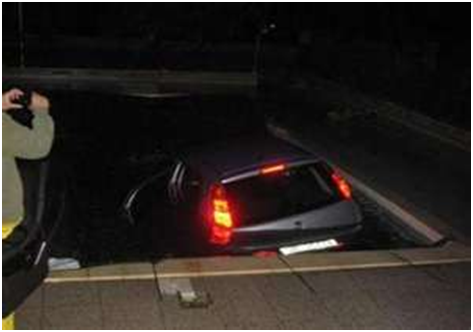
New Vehicle Technology Awareness for Public Safety Divers
January 31st, 2011
Categories
By Paul Bindon & Matt Stroud
We at MGS Tech have been asked the “what if” question many times by agencies; “What if a hybrid or electric vehicle is submerged? What potential extra hazards do we now have with high voltage, SRS and complex body electronic systems?”
Vehicle extrication already has its challenges without adding the element of submersion. As time has passed, vehicle technology has become more complex. The presence of hybrid and electric vehicles on our roads has become more commonplace. Hearsay and misinformation about high voltage vehicles has added another challenge to the hazardous operation of underwater rescue and vehicle recovery.
In this article, we will discuss new vehicle technology (hybrid and electric vehicles) in a submersion scenario, with the goal of a technical understanding that will prevent hesitation when responding to an incident. We dedicate this article to Public Safety Divers and Fire Rescue dive teams who risk their lives to do a job for the benefit of others.
The scenario
You are lounging in your back yard and a vehicle crashes through your fence and into the pool, causing you to spill your beverage of choice all over your speedo. You are close enough to assist the occupants immediately and are equipped by your department with rapid response dive equipment. You have to respond. What if you happen to know that the vehicle is a hybrid? Would you still just jump in? What concerns do you have regarding the technology contained in the vehicle? High voltage (HV) batteries contained in hybrid and electric vehicles (EV’s) are a concern, right? What happens to all that electricity when it is submerged? How long will the battery retain its charge underwater? What will happen to you if you enter the water and attempt to extricate the occupants immediately after it is submerged?
Public safety divers encounter more new technology vehicles in the course of duties than ever before. The type of vehicle is not always apparent until after it is recovered. The training we at MGS Tech have provided to first responders has focused on treating all vehicles the same. From this point forward assume that every vehicle you respond to is a hybrid or electric vehicle so there are no surprises.
High voltage (HV) hybrid systems in vehicles today store electricity in the high voltage battery. The HV battery is used to power the propulsion systems and is not connected to the rest of the vehicle when it is turned off. To turn the vehicle on, 12V computer control is required to energize the relays within the battery that connects it to the rest of the high voltage system. If the vehicle is off, no electricity is present on the high voltage “orange wires” outside of the battery itself.
Voltage storage underwater
All batteries are part of direct current (DC) circuits. This is true whether it’s a small watch battery or a high voltage hybrid car or bus battery containing 100 to 800 volts. DC circuits have current flow that complete a loop circuit from one battery terminal to the other terminal. It follows the path of least resistance to complete the circuit back to itself. That means if the battery becomes submerged the current will not flow from the “+” terminal, out into the water, through you, back out into the water and back to the “–” terminal. It will not, for the same reason, cause the body of the vehicle to become electrically charged. The battery will short internally. SRS deployment by the high voltage system underwater is also not possible for the same reason. The current would have to travel from the high voltage battery terminal, through the water, into one SRS airbag wire, through the airbag, back out the other SRS wire, through the water and back to the battery. The current will instead take the shortest path possible from the “+” terminal within the battery to the “–” terminal within the battery. Airbags require a voltage from the SRS computer to deploy. They will not deploy if electricity is applied to the body of the vehicle as a result of a crash and/or damage. Their wires are not integrated into the vehicle body circuit (ground). Each airbag has its own “+” and “–” wire that are not close enough to the high voltage battery to become energized through the water if the vehicle is submerged.
High voltage DC circuits in hybrid vehicles are also self-contained, and insulated from the rest of the vehicle. They also have their own “+” and “–” wires that do not interface with the body of the vehicle as part of the circuit (ground). All production vehicles are also mandated to have computer monitored safety systems that will isolate the voltage to the battery if damage to the vehicle somehow causes a high voltage system short to the body. Using the body of the vehicle as part of the circuit is, however commonly done with 12V vehicle circuits to simplify the wiring.
For more information, please review the “Basic Electrical Theory” article on our website at http://www.mgstech.net/media/mgs-articles
When the battery is submerged
The amount of time voltage is present inside a high voltage battery when it is submerged depends greatly upon the water quality. Water will conduct electricity better when it has contaminates in it. Clear fresh water has a very high resistance and will not conduct electricity as well as salt water or water containing a high mineral content. The discharge rate of the battery is also dependant on the voltage. You may have encountered a submerged vehicle that still had the headlights on. The fact is a 12 volt vehicle battery will retain its charge underwater much longer than a high voltage hybrid battery underwater. This is because higher voltage is better able to push through the resistance of the water and complete the circuit to the opposite terminal, thus discharging more quickly than a lower voltage battery.
So, what actually happens when a high voltage battery discharges underwater? Hybrid and electric vehicles use Nickel Metal Hydride or Lithium Ion high voltage batteries. When either of these batteries is submerged, the flow of electricity through water from terminal to terminal inside the battery will actually split the H2O water molecule as it discharges. This will produce Hydrogen and Oxygen in a gas form. This process is commonly known as electrolysis. The amount of gas accumulation depends on the original battery voltage, water quality, how well the vehicle is sealed, and the amount of time underwater. To prevent these gases from becoming a fire or explosion hazard if they accumulate, simply ventilate the vehicle appropriately when it is removed from the water by breaking the glass or opening the door.
How electronics react to water
It has been observed that vehicles underwater have functioning headlights and power windows. Visible clues that the 12 volt system is operational may lead us to believe that all systems in the vehicle are still working; however, vehicle computers are not designed to operate in a submerged environment. They will cease to function if they become wet. An example you may have had firsthand experience with is a cell phone falling in the toilet. You might have a small chance to save the phone if you can dry it out properly without turning it on. If you drop that same phone in salt water, it is history! Like the cell phone, when automotive computers get wet, they also cease to function. Early designs of supplemental restraint system (SRS) computers were located in the center console area but real world use by the general public quickly highlighted the need to protect them from spills. Rather than developing submergible computers, auto manufacturers simply provided a shield for the top of the SRS computer to protect it from that “super-size” soda spill. Newer vehicles now locate the SRS computer in a more protected location. They are generally found toward the firewall in the center console area. Similarly, the 12V controlled HV battery computer ceases to function when submerged. The HV system will then cease to function, and voltage will be contained within the battery. There will be no voltage on the orange wires.
Conclusions
The hazards posed by modern hybrid and EV vehicles are not much different than conventional vehicles. While the safety of the diver must still be paramount, the technology contained in the vehicle should not prevent you from performing your duties. You can safely approach these vehicles without fear of electrocution. However, even though newer technology vehicles often contain fewer fluids as compared to conventional vehicles, fluid loss from damaged fuel systems and lubricating oil is still a concern. As with any submersion situation, hazards, including water quality, temperature, entanglement and Hazmat are still present and should be given proper consideration. Adequate protection for the diver must be used in every case possible.
Since it is not always apparent that a vehicle is a hybrid or EV when it is involved in an accident or submersion, it makes sense to treat every vehicle as if it is equipped with a high voltage system, multiple airbags in the SRS system and HID headlights.

